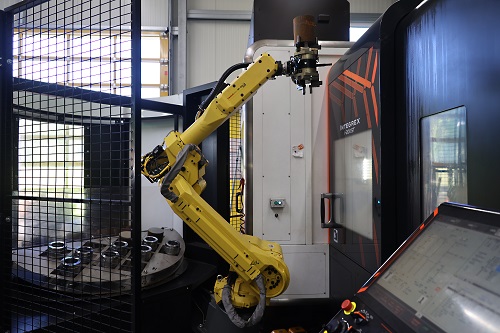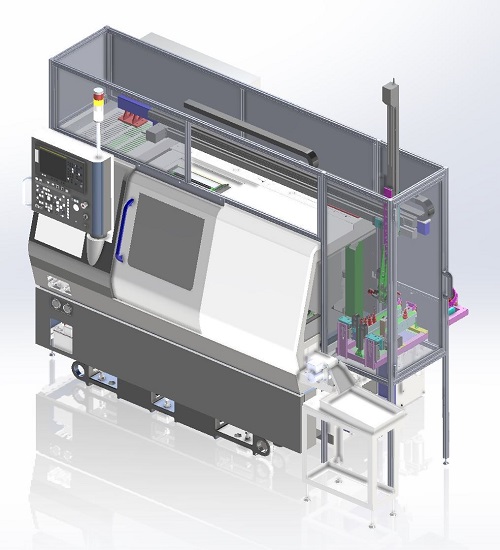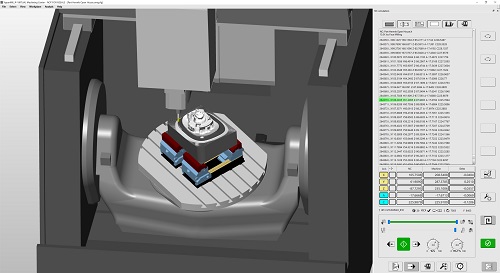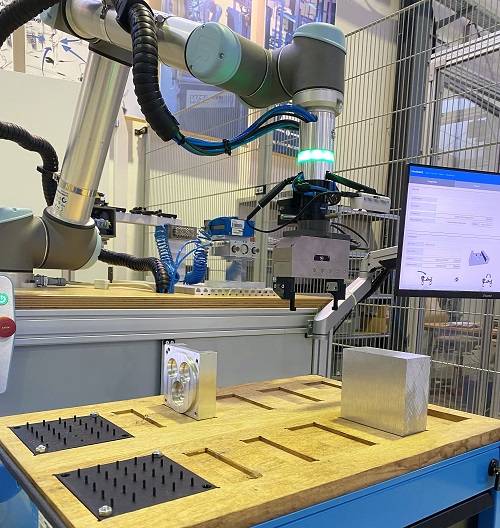Author: Dag Heidecker, daxTR – Technik + Redaktion, Wermelskirchen (www.daxTR.de)
Automation is one of the most important ways in which manufacturing companies can raise their productivity levels and thus remain competitive. And many solutions are now easier to implement today than they were just a few years ago. Furthermore, investments in this segment are now paying for themselves ever faster. This, in turn, is making the systems increasingly attractive for small and medium-sized enterprises. METAV 2022, International Exhibition for Metalworking Technologies in Düsseldorf, Germany, is reflecting the importance of this topic by addressing this dynamic development. Experts from exhibiting companies will be on hand from June 21 to 24 to provide advice and present their different systems.
Automation can double sales
 Halter CNC Automation B.V. is based in Hoevelaken (Netherlands) and has production facilities in Issum on the Lower Rhine. It develops and manufactures sophisticated robotic loading systems that can readily be connected to existing or new CNC machines from different manufacturers. The mobile solutions, which can also accommodate heavy workpieces, can be quickly repositioned if necessary and changed over to a new series in less than five minutes. The great practical potential which the supplier's different automation solutions offer is illustrated by Heinz Knöpfle GmbH, a contract manufacturer for turning, turning-milling and milling based in Schwabmünden near Augsburg. The company invested in a Halter CNC automation system for a CNC turning/milling center in 2018. The advantages of this first robotic cell were so impressive that the company decided to invest in four further automation solutions from Halter CNC Automation in the past two years, including one with a load capacity of up to 70 kg for handling heavy workpieces and long shafts of up to 800 mm in length. These five loading systems allowed Heinz Knöpfle to triple its spindle hours and reposition itself as a contract manufacturer. The company was thus able not only to take on more orders from existing customers, but also to attract a number of new customers, thus doubling its sales.
Halter CNC Automation B.V. is based in Hoevelaken (Netherlands) and has production facilities in Issum on the Lower Rhine. It develops and manufactures sophisticated robotic loading systems that can readily be connected to existing or new CNC machines from different manufacturers. The mobile solutions, which can also accommodate heavy workpieces, can be quickly repositioned if necessary and changed over to a new series in less than five minutes. The great practical potential which the supplier's different automation solutions offer is illustrated by Heinz Knöpfle GmbH, a contract manufacturer for turning, turning-milling and milling based in Schwabmünden near Augsburg. The company invested in a Halter CNC automation system for a CNC turning/milling center in 2018. The advantages of this first robotic cell were so impressive that the company decided to invest in four further automation solutions from Halter CNC Automation in the past two years, including one with a load capacity of up to 70 kg for handling heavy workpieces and long shafts of up to 800 mm in length. These five loading systems allowed Heinz Knöpfle to triple its spindle hours and reposition itself as a contract manufacturer. The company was thus able not only to take on more orders from existing customers, but also to attract a number of new customers, thus doubling its sales.
Gantry loader optimizes cycle times
 Citizen Machinery Europe GmbH has registered growing interest among the short turning sector in automated lathes for inserts and finishing parts. "The great enthusiasm from Japan for one of our series, which included an integrated loading system, gave rise to the idea of equipping two of our machine types in the 42 mm and 51 mm diameter range with a loading and unloading system," reports certified technician and design engineer Matthias Schütz. "However, large numbers of customers dislike many of the existing solutions on the market which have a robotic cell in front of the automatic lathe. They offer very limited machine accessibility and a lot of primary time is lost opening the machine door."
Citizen Machinery Europe GmbH has registered growing interest among the short turning sector in automated lathes for inserts and finishing parts. "The great enthusiasm from Japan for one of our series, which included an integrated loading system, gave rise to the idea of equipping two of our machine types in the 42 mm and 51 mm diameter range with a loading and unloading system," reports certified technician and design engineer Matthias Schütz. "However, large numbers of customers dislike many of the existing solutions on the market which have a robotic cell in front of the automatic lathe. They offer very limited machine accessibility and a lot of primary time is lost opening the machine door."
The solution which the design department of Citizen Machinery Europe developed in cooperation with an axle manufacturer was a 2-axis gantry for loading and unloading the machines. This allows workpieces to be picked up with the correct orientation outside the machine and fed to spindle 1 or 2 as required. A pressure spring in the gripper ensures that the workpiece is pressed firmly against the spindle stop. The finished workpiece can be removed from the opposite spindle in the same cycle. This means that the primary process is only briefly interrupted once for loading and unloading. The overhead shutter access means that the large operator door can remain closed, thus ensuring even shorter cycle times. The accumulation section for unmachined parts and the discharge section for finished parts are usually dimensioned specifically for the relevant parts. In addition, a standardized version is available for upright workpieces of sizes up to L = 120 mm x D = 42 mm. The gripper jaws are manufactured using rapid prototyping and can therefore be made for any workpiece geometry at short notice.
Optimized networking for reliable processes
 Nowadays, central CAD/CAM software needs to be used for the reliable and effective execution of all process steps in complex manufacturing tasks. "Our solution allows companies to carry out all the different tasks in one single system. This begins with reading in the CAD data and ends with the actual processing by the machine," explains Peter Brambs, Director of Product Management & Innovation at Open Mind Technologies AG in Weßling. "Industry 4.0 strategies which involve networking and synchronization can be taken care of by our software via bidirectional data exchange with the controller. Basically, the user sends data to the machine where the corresponding processes are then executed. Conversely, data is also received from the machine. This extensive networking ultimately facilitates real-time synchronization between the CAM and machine worlds."
Nowadays, central CAD/CAM software needs to be used for the reliable and effective execution of all process steps in complex manufacturing tasks. "Our solution allows companies to carry out all the different tasks in one single system. This begins with reading in the CAD data and ends with the actual processing by the machine," explains Peter Brambs, Director of Product Management & Innovation at Open Mind Technologies AG in Weßling. "Industry 4.0 strategies which involve networking and synchronization can be taken care of by our software via bidirectional data exchange with the controller. Basically, the user sends data to the machine where the corresponding processes are then executed. Conversely, data is also received from the machine. This extensive networking ultimately facilitates real-time synchronization between the CAM and machine worlds."
Zero points, tool data and machine parameters can be read out from the control and compared with the programmed CAM data. If the data matches, and the collision check is clear, the machine starts. The CAM system can use integrated remote access to load, start and stop NC programs on the control. In addition, the program sequence is synchronized with the simulation. The simulation therefore allows the personnel to access real processing situations in real time. The CAM and machine worlds are thus optimally interlinked.
Flexible robot support
 More and more companies are struggling to find skilled workers and are looking for solutions which can automate simple and monotonous tasks. Machine tool loading and material handling are still largely performed by operators, as they require a high degree of flexibility. Most orders are for small quantities and involve a wide range of variants, rendering permanently installed loading and/or unloading solutions unprofitable in many cases. "The biggest challenge with flexible loading is that the basic situation is so different for each machine tool. Set-up takes so long that it is often only worthwhile for high volumes," says Prof. Christian Brecher, a member of the board of directors at the Laboratory for Machine Tools and Production Engineering (WZL) of RWTH Aachen University and the Fraunhofer Institute for Production Technology, and vice president of the WGP (German Academic Association for Production Technology). "This results partly from the fact that each machine has its own set of features and that many older machines in particular do not lend themselves readily for automation. At the same time, there are no manufacturer-independent communication standards, based on OPC UA for instance, that enable machine tools and automation systems to be linked flexibly."
More and more companies are struggling to find skilled workers and are looking for solutions which can automate simple and monotonous tasks. Machine tool loading and material handling are still largely performed by operators, as they require a high degree of flexibility. Most orders are for small quantities and involve a wide range of variants, rendering permanently installed loading and/or unloading solutions unprofitable in many cases. "The biggest challenge with flexible loading is that the basic situation is so different for each machine tool. Set-up takes so long that it is often only worthwhile for high volumes," says Prof. Christian Brecher, a member of the board of directors at the Laboratory for Machine Tools and Production Engineering (WZL) of RWTH Aachen University and the Fraunhofer Institute for Production Technology, and vice president of the WGP (German Academic Association for Production Technology). "This results partly from the fact that each machine has its own set of features and that many older machines in particular do not lend themselves readily for automation. At the same time, there are no manufacturer-independent communication standards, based on OPC UA for instance, that enable machine tools and automation systems to be linked flexibly."
In the "FlexARob" research project, a system was set up that significantly simplifies the set-up and programming processes by intelligently integrating information from the engineering department. This allows operators to perform the process independently and without the need for expert support. The project participants also developed a method aimed at optimizing the process and increasing its reliability. Here the robot creates a dynamic environment model with the help of a camera. This ensures that the process runs collision-free.

 iConnectHub
iConnectHub
 Login/Register
Login/Register Supplier Login
Supplier Login


























